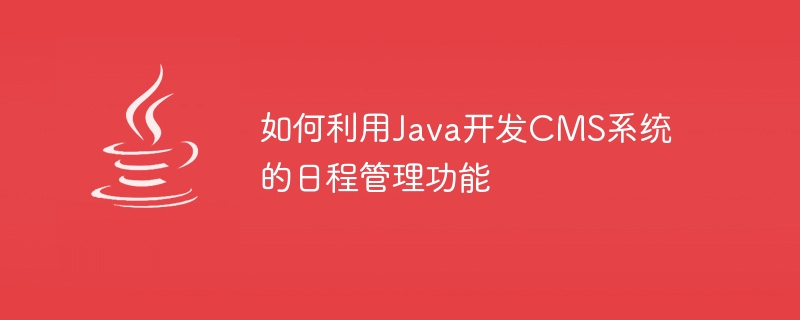

How to use Java to develop the schedule management function of a CMS system
With the development of the Internet, content management systems (CMS) have attracted more and more attention. CMS is a software tool used to create, edit and publish content. It is widely used in the construction of blogs, news websites, corporate portals and other websites. Among them, the schedule management function is one of the very important functions, which can help users manage time and resources effectively. This article will introduce how to use Java to develop the schedule management function of the CMS system and provide corresponding code examples.
First, in the database of the CMS system, we need to design a schedule that contains the following fields:
We can use MySQL or other relational databases to store these data.
Next, we need to create a Java entity class to map the schedule in the database. In this entity class, we define the properties corresponding to the database fields and write the corresponding getter and setter methods.
public class Event {
private int id;
private String title;
private String description;
private Date startTime;
private Date endTime;
private int userId;
// getter and setter methods
}In the data access layer, we need to write the corresponding code to implement the addition, deletion, modification and query operations of schedule data. Here we use JDBC to connect to the database and write corresponding SQL statements.
public class EventDAO {
private static final String INSERT_EVENT_SQL = "INSERT INTO events (title, description, start_time, end_time, user_id) VALUES (?, ?, ?, ?, ?)";
private static final String DELETE_EVENT_SQL = "DELETE FROM events WHERE id = ?";
private static final String UPDATE_EVENT_SQL = "UPDATE events SET title = ?, description = ?, start_time = ?, end_time = ? WHERE id = ?";
private static final String SELECT_EVENT_SQL = "SELECT * FROM events WHERE id = ?";
private static final String SELECT_ALL_EVENTS_SQL = "SELECT * FROM events";
public void addEvent(Event event) {
// 连接数据库并执行INSERT语句
}
public void deleteEvent(int eventId) {
// 连接数据库并执行DELETE语句
}
public void updateEvent(Event event) {
// 连接数据库并执行UPDATE语句
}
public Event getEvent(int eventId) {
// 连接数据库并执行SELECT语句,将结果封装到一个Event对象中并返回
}
public List<Event> getAllEvents() {
// 连接数据库并执行SELECT语句,将结果封装到一个List<Event>对象中并返回
}
}In the business logic layer, we provide some methods as needed for other modules to call.
public class EventService {
private EventDAO eventDAO = new EventDAO();
public void addEvent(Event event) {
eventDAO.addEvent(event);
}
public void deleteEvent(int eventId) {
eventDAO.deleteEvent(eventId);
}
public void updateEvent(Event event) {
eventDAO.updateEvent(event);
}
public Event getEvent(int eventId) {
return eventDAO.getEvent(eventId);
}
public List<Event> getAllEvents() {
return eventDAO.getAllEvents();
}
}Finally, we can write user interface code and use GUI libraries such as Swing or JavaFX to create a schedule management interface for a CMS system.
public class ScheduleManagerUI {
private EventService eventService = new EventService();
// 创建用户界面的相关代码
public static void main(String[] args) {
// 启动用户界面
}
}Through the above steps, we have completed the development of the schedule management function of the CMS system using Java. When using this feature, we can add, delete, edit and view schedules through the user interface. At the same time, through the code of the data access layer and business logic layer, we can persist the schedule data into the database and provide corresponding query and operation functions. Throughout the process, Java provides a wealth of libraries and tools, allowing us to quickly and easily develop efficient and stable schedule management functions.
The above is the detailed content of How to use Java to develop the schedule management function of CMS system. For more information, please follow other related articles on the PHP Chinese website!
